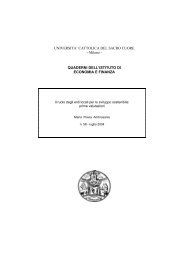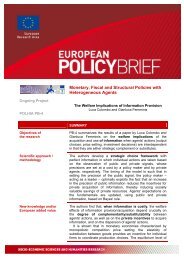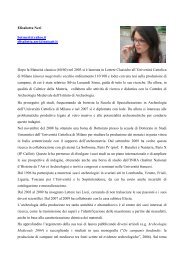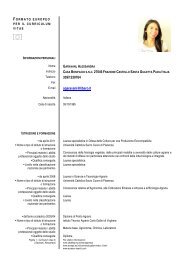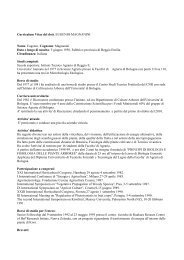REGULATION, FORMAL AND INFORMAL ... - ResearchGate
REGULATION, FORMAL AND INFORMAL ... - ResearchGate
REGULATION, FORMAL AND INFORMAL ... - ResearchGate
Create successful ePaper yourself
Turn your PDF publications into a flip-book with our unique Google optimized e-Paper software.
1. Introduction 1<br />
The Italian household loan market has three significant features. First, it is much smaller than<br />
those of other countries at a comparable stage of economic development. In 2000 in Italy total<br />
household debt amounted to 43 percent of disposable income, about half the average of the<br />
euro-area countries and much smaller than the US figure of 107 percent.<br />
Second, over the past decade lending to households has been growing very fast, at rates<br />
higher than those in the other main European countries. Setting the stock of outstanding loans to<br />
households in 1997 equal to 100, the index jumps to 183 in 2003 in Italy, compared with 152 in<br />
the euro area. The difference also holds when consumer credit and mortgages are considered<br />
separately. However, the Italian growth was not fast enough to close the gap in market size, and<br />
the Italian market remains small by international standards.<br />
The third relevant feature is that households’ ease in obtaining credit differs greatly and<br />
systematically across local markets. Guiso, Sapienza and Zingales (2004a), use data from the<br />
Italian Survey of Household Income and Wealth (SHIW) to construct an index of households’<br />
access to the credit market across Italian regions. Controlling for individual characteristics and<br />
for market risk, the probability to obtain a loan in Marche, the region with easiest access, is 50<br />
per cent higher than in Calabria, where access is most difficult. Put differently, there is<br />
considerable dispersion across Italian regions in the degree of development of the market for<br />
household loans, as measured by this gauge.<br />
In this paper we use these features to examine the determinants of the size of the household<br />
loan market. Geographical dispersion within Italy in the size of the market and time variation it<br />
is about the same as we observe in a cross-section of countries; this is a major advantage<br />
because by focusing on a single country, we can look at the determinants of the development of<br />
the household loan market in an environment where a large number of potentially relevant<br />
factors - which in a cross section of nations cannot be controlled for owing to lack of degrees of<br />
freedom - are naturally held constant. This way we have a better chance of identifying the<br />
1 The authors are grateful to Giuseppe Bertola for useful comments. The opinions expressed in this paper are<br />
those of the authors only and in no way involve the responsibility of the institutions they are affiliated to. This<br />
paper is a preliminary version of a chapter for G. Bertola, C. Grant and R. Disney (eds.), The Economics of<br />
Consumer Credit: European Experience and Lessons from the US, MIT Press, forthcoming.




